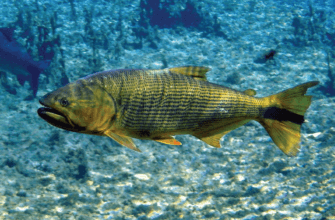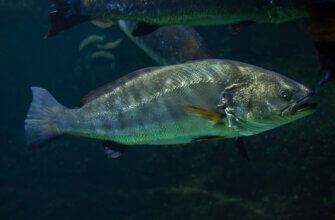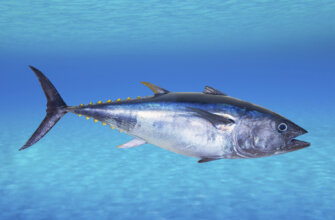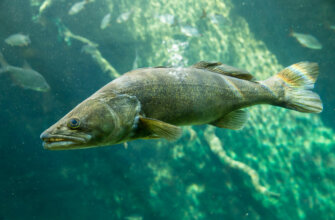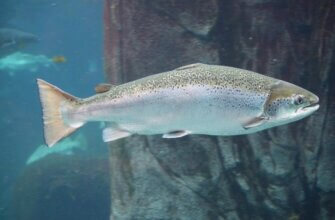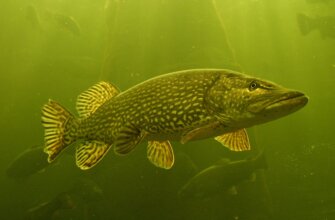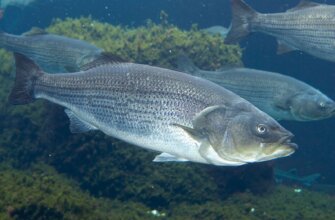Snook is a type of game fish that is found in warm coastal waters around the world, particularly in the Atlantic Ocean and the Gulf of Mexico. It is known for its firm, white flesh and mild flavor, which make it a popular choice for cooking and eating.
Snook are typically olive or gray in color, with a prominent black lateral line that runs from their gills to their tails. They have a pointed head, a sloping forehead, and a protruding lower jaw that gives them a distinctive appearance.
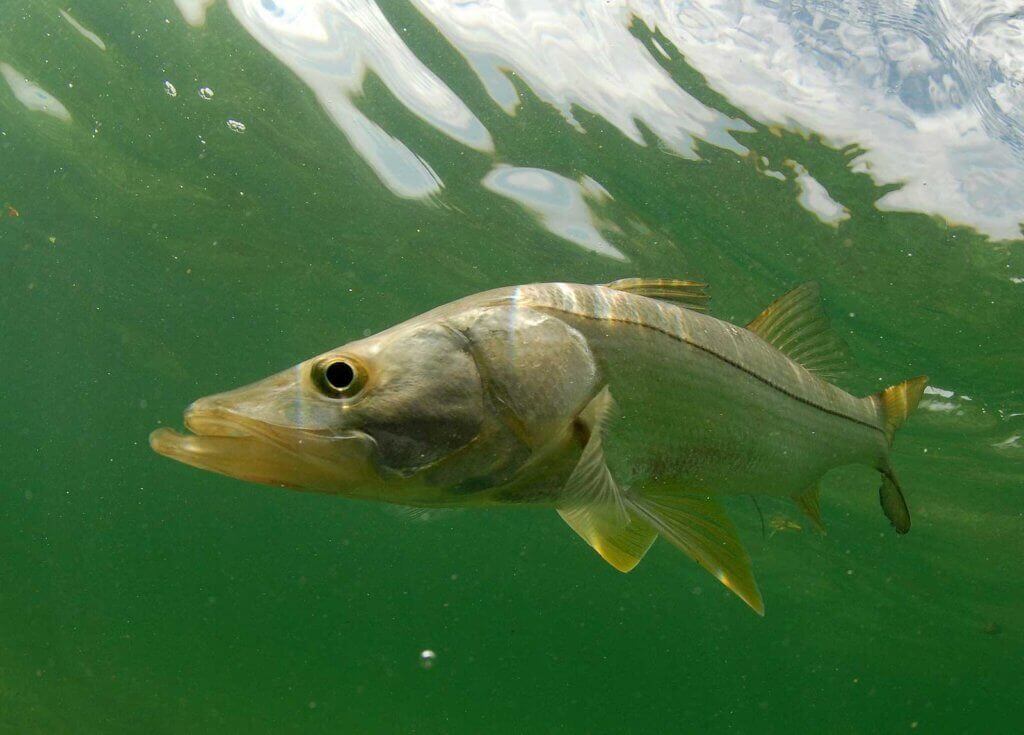
Snook are predatory fish that feed primarily on other fish, as well as crustaceans and mollusks. They are known for their acrobatic jumps and strong fighting ability, which make them a popular game fish for anglers.
Due to their popularity and demand, snook populations have been threatened by overfishing and habitat loss. As a result, many areas have established regulations and conservation efforts to protect snook populations and maintain sustainable fishing practices.
Species
There are several species of snook, including:
- Common Snook (Centropomus undecimalis). Also known as the Atlantic Snook or Robalo, this is the most widespread and commonly caught species of snook. It is found in the western Atlantic Ocean from southern Florida to Brazil, as well as in the Gulf of Mexico and the Caribbean.
- Fat Snook (Centropomus parallelus). Found in the western Atlantic Ocean from North Carolina to Brazil, this species is similar in appearance to the Common Snook but has a more rounded head and a shorter lateral line.
- Tarpon Snook (Centropomus pectinatus). Found in the western Atlantic Ocean from southern Florida to Venezuela, this species is smaller than the Common Snook and has a more pronounced lateral line.
- Swordspine Snook (Centropomus ensiferus). Found in the eastern Pacific Ocean from southern California to Peru, this species has a longer body and a more pointed head than the Atlantic snooks.
- Black Snook (Centropomus nigrescens). Found in the eastern Pacific Ocean from Mexico to Peru, this species has a dark coloration and is smaller than the Swordspine Snook.
All species of snook have similar characteristics and are prized by anglers for their fighting ability and delicious taste. However, conservation efforts are necessary to protect their populations and ensure their sustainability for future generations.
Appearance
Snook have a distinctive appearance that sets them apart from other fish. They are typically elongated with a sloping forehead and a protruding lower jaw. Their body is cylindrical and tapers towards the tail, which is forked.
The coloration of snook can vary depending on their environment, but they are usually a silver-green or gray color on their upper body, with a white or yellowish underbelly. They have a dark, prominent lateral line that runs from their gills to their tail, which is a key characteristic used to identify the species.
Snook have a dorsal fin that is located towards the middle of their body and is divided into two distinct parts. The front part of the dorsal fin is spiny and rigid, while the rear part is soft and flexible. They also have an anal fin and pectoral fins, which are used for maneuvering and balance.
Overall, snook are a striking and unique looking fish that are highly sought after by anglers for their beauty and fighting ability.
Size and weight
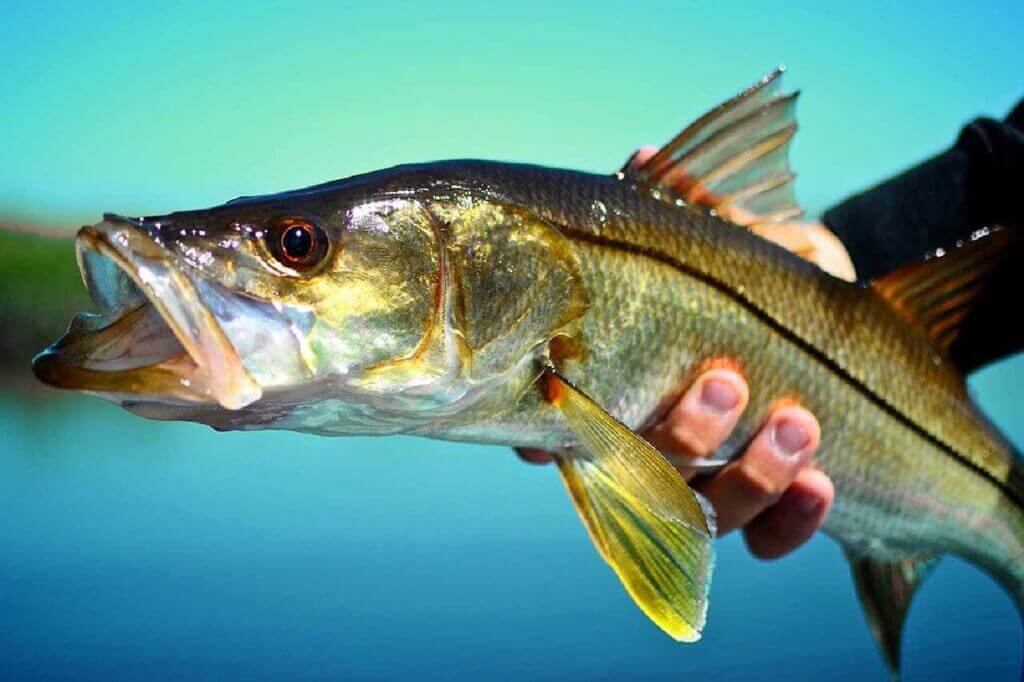
Snook can vary in size depending on the species and their environment. The Common Snook, which is the most widespread species, can reach lengths of up to 48 inches (122 cm) and can weigh as much as 53 pounds (24 kg). However, most Common Snook caught by anglers are between 20-40 inches (50-100 cm) in length and weigh between 5-20 pounds (2-9 kg).
Other species of snook are generally smaller than the Common Snook. The Fat Snook, for example, typically reaches lengths of up to 20 inches (50 cm) and weighs between 2-3 pounds (0.9-1.4 kg). The Tarpon Snook is even smaller, reaching lengths of up to 12 inches (30 cm) and weighing around 1 pound (0.5 kg).
It is important to note that snook populations have been threatened by overfishing and habitat loss, so regulations and conservation efforts are in place in many areas to protect the species. In some places, there are limits on the size and number of snook that can be caught, and catch-and-release practices are encouraged to maintain sustainable populations.
Diet
Snook are predatory fish and have a varied diet that mainly consists of other fish, crustaceans, and mollusks. They are opportunistic feeders and will eat whatever prey is available to them in their environment.
Juvenile snook typically feed on small crustaceans, such as shrimp and crabs, and small fish like anchovies and sardines. As they grow larger, their diet expands to include larger fish like mullet, menhaden, and pinfish.
Adult snook will also feed on larger crustaceans like crabs and lobsters, as well as mollusks like squid and octopus. They are known to be ambush predators, and will often hide in structures like mangroves, bridges, and docks to surprise their prey.
In some areas, snook have also been known to feed on baitfish used by anglers, such as sardines and threadfin herring, which can make them easier to catch.
Overall, snook have a diverse and adaptable diet, which allows them to thrive in a variety of environments and ecosystems.
Behavior
Snook are a highly sought-after game fish, known for their strong fighting ability and elusive nature. They are a predatory species that typically inhabit inshore and estuarine environments, such as mangroves, docks, and bridges, where they can find cover and ambush their prey.
Snook are a solitary species and are generally found alone or in small groups, except during spawning season when they gather in large schools. They are most active during low-light periods, such as dawn and dusk, and are known to be more active during the warmer months.
When hunting, snook will often ambush their prey from cover, using their powerful jaws to quickly grab and swallow their prey. They are fast swimmers and can accelerate quickly to chase down fleeing prey. Snook are also known for their jumping ability, which they may use to dislodge a hook or to escape from predators.
During spawning season, which typically occurs during the summer months, snook gather in large schools and migrate to their spawning grounds, which are often located in nearshore waters or river mouths. After spawning, the adult snook return to their regular habitat.
Overall, snook are a fascinating species with unique behaviors and characteristics, which make them a popular target for recreational anglers. However, it is important to practice responsible fishing practices, such as catch-and-release, to protect their populations and ensure their sustainability for future generations.
Spawning
Snook have a unique spawning behavior that takes place during the summer months in nearshore waters and river mouths. The timing and location of spawning can vary depending on the species and the location.
When it’s time to spawn, adult snook migrate in large schools to their spawning grounds. During this time, the males and females will engage in a courtship behavior that involves swimming in circles and rubbing their bodies together.
The females will release their eggs, which are fertilized by the males. The eggs are then scattered and drift with the current until they hatch into larvae, which develop into juvenile snook.
After spawning, the adult snook will return to their regular habitat, and the juveniles will begin their journey to the estuarine environments where they will grow and mature.
Spawning can be an energy-intensive process for snook, and they may be more vulnerable to predation during this time. In some areas, fishing restrictions and closed seasons are in place during spawning season to protect the populations.
Overall, snook spawning is an important aspect of their life cycle, and understanding their behavior can help with conservation efforts to protect their populations for the future.
Fishing
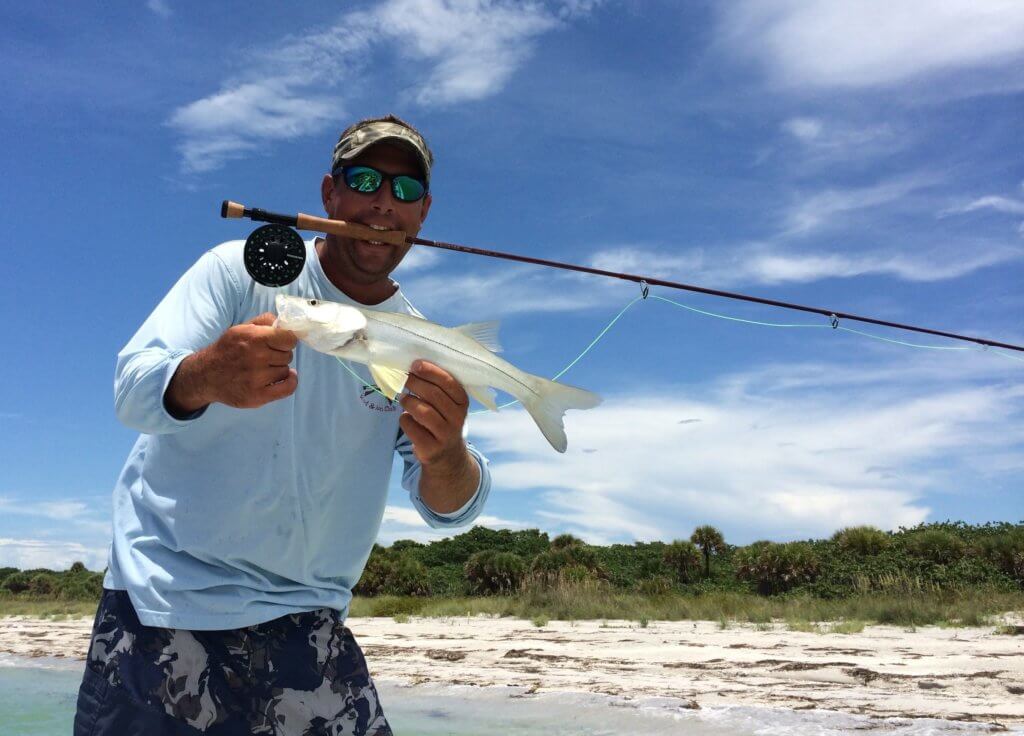
Snook are a popular game fish that are highly sought after by anglers due to their strong fighting ability and elusive nature. However, it is important to practice responsible fishing practices to ensure their sustainability for future generations.
When fishing for snook, it is important to first check the local regulations and restrictions in the area. In many places, there are size limits and bag limits on snook, and catch-and-release practices are encouraged to protect the populations.
Snook can be caught using a variety of methods, including live bait, artificial lures, and fly fishing. Common live baits include shrimp, pinfish, and mullet, while popular artificial lures include jigs, spoons, and topwater plugs.
When targeting snook, it is important to pay attention to their behavior and habitat. Snook are often found in structures like mangroves, docks, and bridges, where they can find cover and ambush their prey. They are also most active during low-light periods, such as dawn and dusk.
It is important to handle snook with care when caught, as they are sensitive to stress and rough handling. When releasing snook, it is best to minimize the amount of time they are out of the water and handle them gently to avoid injuring them.
Overall, fishing for snook can be a rewarding experience for anglers, but it is important to practice responsible fishing practices to ensure their sustainability and conservation for future generations.
Lures
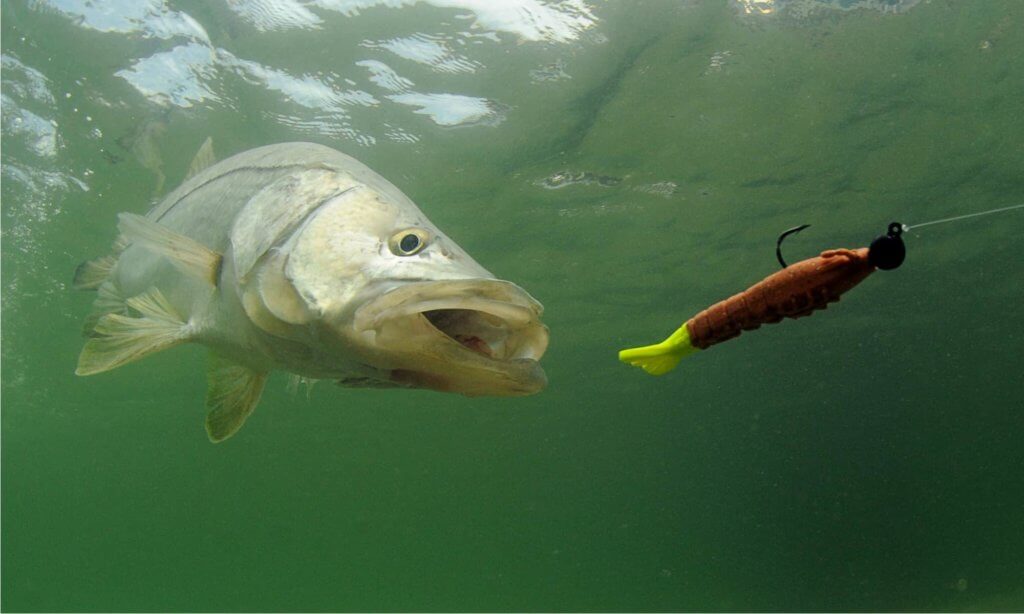
Snook can be caught using a variety of lures, including jigs, spoons, topwater plugs, and soft plastic baits. The choice of lure will depend on the conditions and the behavior of the snook in the area.
Jigs are a popular lure for snook, particularly in deeper water or areas with a strong current. Jigs are available in a variety of weights and colors, and can be tipped with live bait or plastic tails to entice a strike.
Spoons are another effective lure for snook, particularly when fishing in shallow water or around structure like mangroves or docks. Spoons come in a variety of sizes and colors, and can be retrieved at a slow or fast speed to imitate a fleeing baitfish.
Topwater plugs are a popular choice for anglers targeting snook in low-light conditions, such as dawn or dusk. These lures create a commotion on the surface of the water, which can attract the attention of nearby snook. They can be retrieved with a steady or erratic motion to imitate a wounded baitfish.
Soft plastic baits are another versatile option for snook fishing. These lures can be rigged weedless or with a jig head, and can be fished in a variety of ways to imitate different types of prey. They are particularly effective in shallow water or around structure.
When choosing a lure for snook, it is important to match the size and color to the local baitfish and the conditions in the area. It is also important to vary the speed and retrieve of the lure until you find what is most effective for that day and location.
Sure, here are some examples of popular fishing lures for snook, along with their models and specifications:
- DOA Shrimp – This soft plastic bait is a popular choice for snook fishing, and comes in a variety of colors and sizes. The DOA Shrimp is designed to mimic the movement and appearance of a live shrimp, and can be rigged weedless or with a jig head. Specifications: Length – 3 inches, Weight – 1/4 oz.
- MirrOlure Mirrodine – The Mirrodine is a suspending twitchbait that is effective for snook fishing in shallow water or around structure. It has a realistic appearance and an erratic darting action that can trigger strikes from nearby snook. Specifications: Length – 2.75 inches, Weight – 3/8 oz.
- Yo-Zuri Crystal 3D Minnow – This hard-bodied lure is designed to mimic the appearance and movement of a wounded baitfish, making it an effective choice for snook fishing. The Yo-Zuri Crystal 3D Minnow has a holographic finish that reflects light and attracts the attention of nearby fish. Specifications: Length – 4.25 inches, Weight – 1/2 oz.
- Z-Man DieZel MinnowZ – The DieZel MinnowZ is a soft plastic bait that can be rigged weedless or with a jig head, and has a realistic swimming action that can attract the attention of nearby snook. It is available in a variety of colors and sizes to match the local baitfish. Specifications: Length – 4 inches, Weight – 1/4 oz.
- Heddon Super Spook Jr. – The Super Spook Jr. is a popular topwater plug that can create a commotion on the surface of the water and attract the attention of nearby snook. It has a realistic appearance and an erratic walking action that can trigger strikes. Specifications: Length – 3.5 inches, Weight – 1/2 oz.
These are just a few examples of popular lures for snook fishing. When choosing a lure, it is important to match the size and color to the local baitfish and the conditions in the area. It is also important to vary the speed and retrieve of the lure until you find what is most effective for that day and location.
Baits
Snook can be caught using a variety of baits, both live and artificial.
The choice of bait will depend on the conditions and the behavior of the snook in the area:
- Live Bait – Live bait is one of the most effective ways to catch snook. Common live baits used for snook fishing include shrimp, pilchards, pinfish, and mullet. Live bait can be fished on a hook with or without a weight, and can be cast or drifted depending on the conditions.
- Cut Bait – Cut bait can also be effective for snook fishing, particularly when fishing around structure like docks or bridges. Common cut baits for snook include mullet, ballyhoo, and squid. Cut bait can be fished on a hook with or without a weight, and can be cast or drifted depending on the conditions.
- Jigs – Jigs tipped with soft plastic tails can also be effective for snook fishing. The jig can be cast and retrieved along the bottom or near structure, and the soft plastic tail can mimic the movement of a live baitfish.
- Topwater Plugs – Topwater plugs can be effective for snook fishing in low-light conditions, such as dawn or dusk. These lures create a commotion on the surface of the water, which can attract the attention of nearby snook. They can be retrieved with a steady or erratic motion to imitate a wounded baitfish.
When choosing a bait for snook, it is important to match the size and color to the local baitfish and the conditions in the area. It is also important to vary the speed and retrieve of the bait until you find what is most effective for that day and location.
Rods
When it comes to selecting a fishing rod for snook, there are a few factors to consider such as the type of fishing you’ll be doing, the size of the fish you are targeting, and the conditions you’ll be fishing in.
Here are some details to keep in mind when choosing a snook fishing rod:
- Length. A good snook fishing rod should be at least 7 feet long. Longer rods can provide greater casting distance and help to keep the line out of the water, which can be especially helpful when fishing from a boat or kayak. However, shorter rods can be more maneuverable when fishing in tight spaces or around structure.
- Power and Action. The power of a rod refers to its ability to handle different lure weights and the strength of the fish you are targeting. For snook, a medium-heavy to heavy power rod is recommended. The action of a rod refers to how much it bends when pressure is applied to the tip. For snook, a fast or extra-fast action rod is preferred as it provides greater sensitivity and better hook setting power.
- Material. Snook fishing rods are typically made of graphite or composite materials, which offer good sensitivity and durability. Graphite rods are more sensitive but may not be as durable as composite rods.
- Handle. The handle of a fishing rod is an important factor to consider, as it affects your comfort and grip while fishing. Look for a handle that fits comfortably in your hand and provides a good grip, even when wet. Handles can be made of cork, EVA foam, or other materials.
- Guides. The guides on a fishing rod are the small rings that help to guide the fishing line along the rod. Look for guides made of high-quality materials, such as ceramic or titanium, that can withstand the abrasive effects of saltwater.
Some popular snook fishing rod brands include St. Croix, G. Loomis, and Shimano. When selecting a rod, it’s important to consider your personal preferences and the type of fishing you’ll be doing to ensure that you choose the right rod for your needs.
Here are some examples of fishing rods that are suitable for catching snook, along with their specifications:
- St. Croix Mojo Inshore Spinning Rod: This rod is designed specifically for inshore saltwater fishing, making it a great option for snook. It is available in various lengths and power ratings, but a 7-foot, medium-heavy power rod with a fast action is recommended for snook. The rod is made of high-quality graphite, features corrosion-resistant guides, and has a comfortable cork handle.
- G. Loomis E6X Inshore Spinning Rod: The G. Loomis E6X is a lightweight, high-performance spinning rod that is ideal for catching snook. It is available in different lengths and power ratings, but a 7’6″ medium-heavy power rod with a fast action is a good option for snook fishing. The rod is made of a blend of high-quality graphite and composite materials and features Fuji guides and a cork handle.
- Shimano Teramar TMS-X70MH Spinning Rod: This is a versatile, high-quality rod that is suitable for catching a variety of saltwater game fish, including snook. It is a 7-foot medium-heavy power rod with a fast action, making it great for casting lures and setting the hook on a big snook. The rod is made of a blend of graphite and composite materials, has Fuji guides, and features a comfortable cork handle.
- Penn Battalion Inshore Spinning Rod: The Penn Battalion is a durable and high-performance rod that is designed for inshore saltwater fishing. It is available in different lengths and power ratings, but a 7-foot medium-heavy power rod with a fast action is recommended for snook. The rod is made of graphite and features Fuji guides and a comfortable EVA handle.
Remember, the best fishing rod for snook depends on personal preference and the type of fishing you plan to do. Be sure to choose a rod that is appropriate for the size of the fish you are targeting and the conditions you’ll be fishing in.
Dishes
Snook is a popular fish among anglers and is also delicious to eat. It has a firm texture and a mild, sweet flavor that is similar to other white fish such as sea bass or grouper.
Here are some examples of dishes that can be made with snook:
- Grilled Snook. Grilling is a simple and delicious way to prepare snook. Season the fish with salt, pepper, and your favorite herbs or spices, then grill over medium-high heat until cooked through. Serve with grilled vegetables, rice, or a salad.
- Snook Ceviche. Ceviche is a popular dish in Latin American cuisine that involves marinating raw fish in citrus juice. To make snook ceviche, cube the fish and marinate it in lime juice, salt, and chopped cilantro for a few hours. Serve with tortilla chips or over a bed of lettuce.
- Snook Tacos. Tacos are a great way to enjoy snook. Season the fish with a mix of cumin, chili powder, and garlic, then pan-fry or grill until cooked through. Serve with corn tortillas, avocado, and a spicy salsa.
- Snook Chowder. Snook can also be used to make a delicious seafood chowder. Saute onions, celery, and potatoes in butter, then add fish stock and cubed snook. Simmer until the fish is cooked through, then add heavy cream and fresh herbs for extra flavor.
When cooking snook, it’s important to keep in mind that it is a delicate fish that can easily overcook. Be sure to use gentle cooking methods and avoid overcooking to ensure that the fish stays tender and moist.

